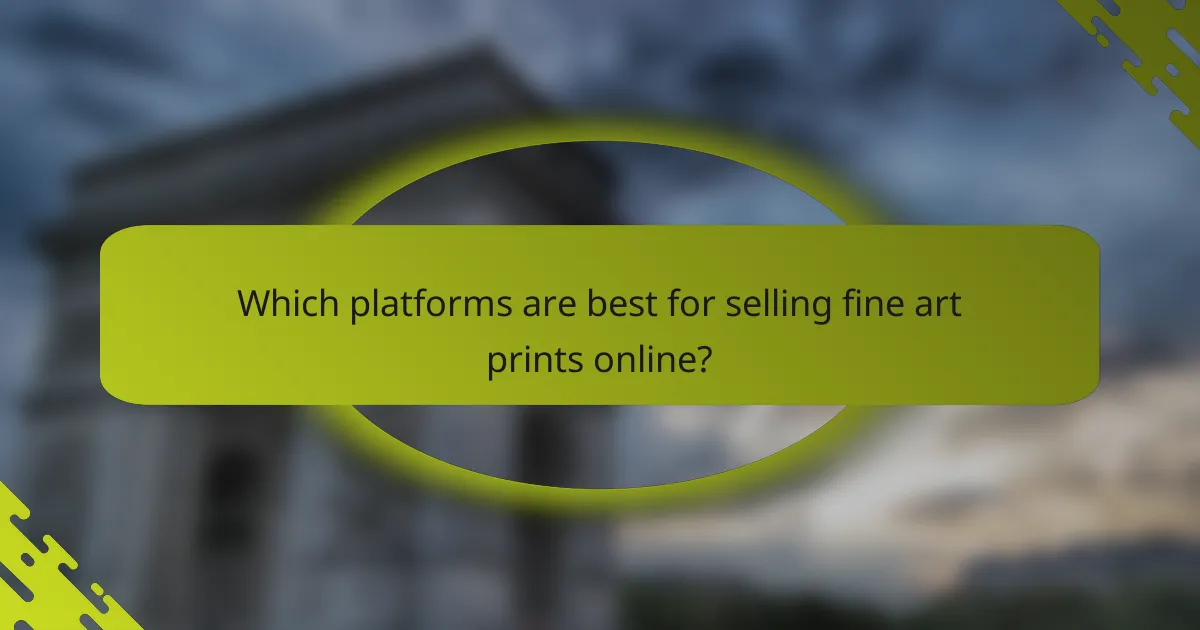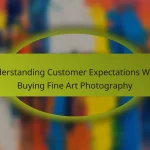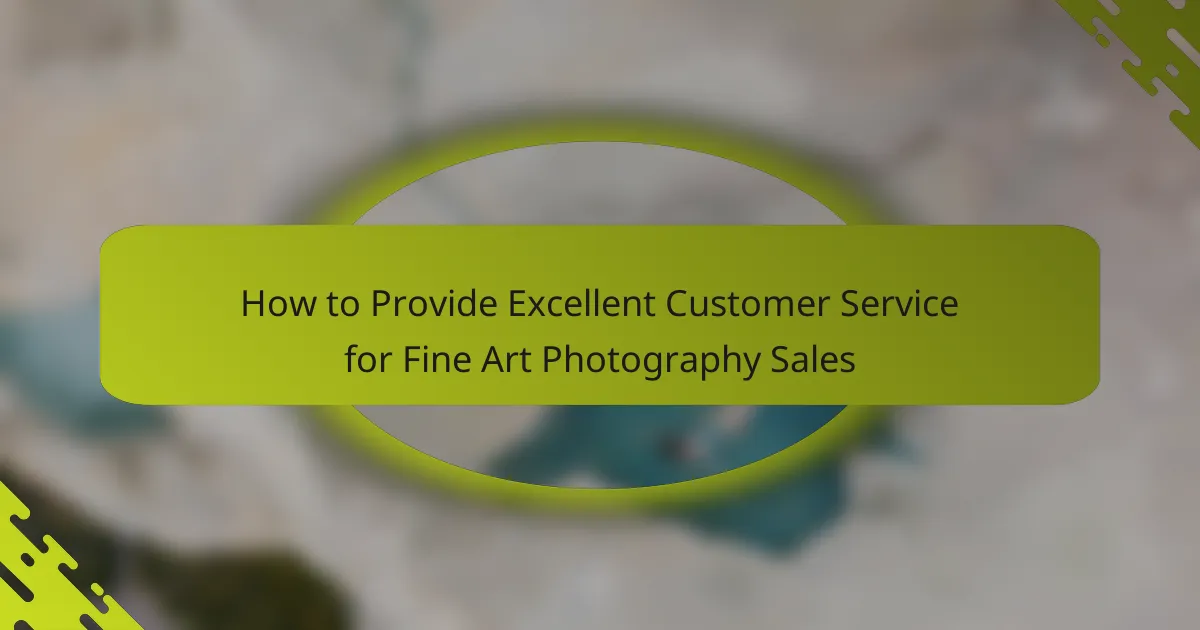Enhancing the online shopping experience for fine art prints is essential for attracting and retaining customers. By leveraging technologies like augmented reality and personalized recommendations, platforms can create immersive environments that allow buyers to visualize art in their own spaces and streamline the purchasing process. Implementing these strategies not only boosts customer satisfaction but also increases conversion rates, making it easier for art enthusiasts to find and purchase the pieces they love.

How can you improve the online shopping experience for fine art prints?
Improving the online shopping experience for fine art prints involves enhancing product visualization, offering personalized recommendations, and streamlining the checkout process. These strategies can significantly increase customer satisfaction and conversion rates.
Enhanced product visualization
Enhanced product visualization allows customers to see fine art prints in detail, helping them make informed purchasing decisions. High-resolution images, 360-degree views, and contextual displays (like prints in a room setting) can create a more immersive experience.
Consider integrating augmented reality (AR) features that let users visualize how a print would look on their wall. This technology can reduce uncertainty and increase the likelihood of a purchase.
Personalized recommendations
Personalized recommendations can significantly enhance the shopping experience by suggesting art prints based on a user’s browsing history and preferences. Utilizing algorithms to analyze customer behavior helps in curating a tailored selection of artworks that align with individual tastes.
Implementing features like “Customers who bought this also liked” or “Recommended for you” can guide users toward prints they may not have discovered otherwise, increasing engagement and sales.
Streamlined checkout process
A streamlined checkout process minimizes friction and encourages customers to complete their purchases. Simplifying forms, offering guest checkout options, and providing multiple payment methods can significantly reduce cart abandonment rates.
Consider using a progress indicator during the checkout process to inform users of their steps. Additionally, ensure that the site is mobile-friendly, as many users shop on their smartphones, and a seamless experience can lead to higher conversion rates.

What technologies enhance online art shopping?
Technologies such as augmented reality and virtual galleries significantly improve the online shopping experience for fine art prints. These tools allow customers to visualize artwork in their own spaces and explore diverse collections from the comfort of their homes.
Augmented reality tools
Augmented reality (AR) tools enable potential buyers to see how a piece of art would look in their own environment. By using a smartphone or tablet, customers can overlay digital images of art prints onto their walls, helping them make informed decisions about size and style.
When implementing AR, consider the quality of the app and its ease of use. Look for platforms that offer high-resolution images and intuitive interfaces. Popular AR applications can provide a realistic preview, which can increase customer confidence and reduce return rates.
Virtual galleries
Virtual galleries create immersive online experiences where users can browse art collections as if they were in a physical gallery. These platforms often feature 3D environments that replicate the feel of walking through an art space, allowing for a more engaging exploration of artworks.
To enhance virtual galleries, ensure that the navigation is user-friendly and that artworks are displayed with high-quality images and detailed descriptions. Consider integrating features like artist interviews or background stories to enrich the viewer’s connection to the art. This approach can lead to higher engagement and potentially boost sales.

Which platforms are best for selling fine art prints online?
The best platforms for selling fine art prints online include Shopify, Etsy, and Saatchi Art. Each platform offers unique features and benefits tailored to different types of artists and audiences.
Shopify for artists
Shopify is an excellent choice for artists looking to create a personalized online store. It allows for extensive customization, enabling you to showcase your fine art prints in a way that reflects your brand identity.
Consider the monthly fees and transaction costs, which can vary based on the plan you choose. Shopify is ideal for artists who want full control over their sales process and customer experience.
Etsy for handmade prints
Etsy is a popular marketplace specifically for handmade and vintage items, making it a great platform for selling fine art prints. It connects you with a large audience interested in unique, artisanal products.
Listing fees are relatively low, but keep in mind that Etsy charges a percentage of each sale. This platform is suitable for artists who want to reach buyers who appreciate craftsmanship and originality.
Saatchi Art for global reach
Saatchi Art focuses on connecting artists with collectors worldwide, making it an excellent platform for those seeking a global audience for their fine art prints. It offers a curated experience, which can enhance visibility and credibility.
While Saatchi Art takes a commission on sales, it provides marketing support and exposure to art enthusiasts. This platform is ideal for artists looking to expand their reach beyond local markets.

How to optimize product descriptions for fine art prints?
To optimize product descriptions for fine art prints, focus on clarity and detail to engage potential buyers. Highlight the unique aspects of each print, including visual quality, artist background, and technical specifications.
Use high-quality images
High-quality images are crucial for showcasing fine art prints effectively. Use images that are at least 1500 pixels on the shortest side to ensure clarity and detail. Consider including multiple angles and close-ups to give customers a comprehensive view of the artwork.
Additionally, utilize zoom functionality on your website to allow customers to examine textures and colors closely. This can significantly enhance their online shopping experience and increase the likelihood of a purchase.
Include artist background
Providing background information about the artist adds depth to the product description and can create a connection with potential buyers. Include details such as the artist’s education, influences, and notable exhibitions or awards.
Highlighting the artist’s story can evoke emotional responses and enhance the perceived value of the print. This context can be particularly compelling for collectors and those looking to support emerging artists.
Detail print specifications
Detailing print specifications is essential for informing customers about what they are purchasing. Include information such as the type of paper used, print size, and whether the print is framed or unframed. Specify if the print is a limited edition and include the edition number if applicable.
Consider including details about the printing process, such as giclée or lithography, as this can influence the quality and longevity of the print. Clear specifications help customers make informed decisions and reduce the likelihood of returns.

What are the best practices for shipping fine art prints?
To enhance the shipping experience for fine art prints, focus on using protective packaging, offering tracking options, and providing clear return policies. These practices ensure that prints arrive safely and that customers feel secure in their purchases.
Use protective packaging
Protective packaging is essential for shipping fine art prints to prevent damage during transit. Use sturdy boxes or tubes that can withstand pressure and impacts. Additionally, include cushioning materials like bubble wrap or foam to secure the prints inside the packaging.
Consider using acid-free materials to avoid any chemical reactions that could harm the artwork. For flat prints, a rigid backing can help maintain shape and prevent bending.
Offer tracking options
Providing tracking options is crucial for customer satisfaction and transparency. Customers appreciate being able to monitor the status of their shipments in real-time, which reduces anxiety about delivery times.
Integrate tracking services with your shipping provider to send automatic updates via email or SMS. This can include notifications when the item is shipped, out for delivery, and successfully delivered.
Provide clear return policies
Clear return policies help build trust with customers and reduce the likelihood of disputes. Clearly outline the conditions under which returns are accepted, such as damage during shipping or dissatisfaction with the product.
Consider offering a reasonable return window, typically ranging from 14 to 30 days, and specify whether customers will be responsible for return shipping costs. Make sure this information is easily accessible on your website to avoid confusion.

How can customer feedback improve the shopping experience?
Customer feedback is essential for enhancing the online shopping experience for fine art prints. By actively collecting and analyzing feedback, businesses can identify areas for improvement, build trust, and create a more user-friendly environment.
Incorporate reviews and ratings
Incorporating reviews and ratings allows potential buyers to gauge the quality and satisfaction of previous customers. Displaying a rating system, such as a five-star scale, can help users quickly assess the popularity of specific prints.
Consider encouraging customers to leave detailed reviews that highlight aspects like print quality, shipping speed, and customer service. This information can guide new buyers in making informed decisions and increase overall confidence in their purchases.
Utilize customer testimonials
Customer testimonials provide powerful social proof that can enhance credibility. Featuring quotes from satisfied customers on product pages or a dedicated testimonials section can create a personal connection and encourage others to buy.
To maximize impact, select testimonials that address common concerns or highlight unique features of the art prints. Including the customer’s name and location can add authenticity, making the testimonials more relatable and trustworthy.

What are the key trends in online art sales?
The online art sales landscape is evolving rapidly, with several key trends shaping how consumers purchase fine art prints. Notably, the rise of digital platforms has made art more accessible, while consumer preferences are shifting towards unique and limited edition pieces.
Increased demand for limited editions
Limited edition prints are becoming increasingly popular among art buyers, as they offer exclusivity and potential investment value. Collectors often seek out these pieces because they can appreciate in value over time, making them attractive for both personal enjoyment and financial gain.
When selling limited editions, artists and galleries should clearly communicate the number of prints available and the unique qualities of each piece. This transparency helps build trust and enhances the perceived value of the artwork.
To capitalize on this trend, consider offering a small number of high-quality limited editions rather than a large inventory of open editions. This strategy not only creates urgency among buyers but also fosters a sense of community among collectors who appreciate owning something rare.










